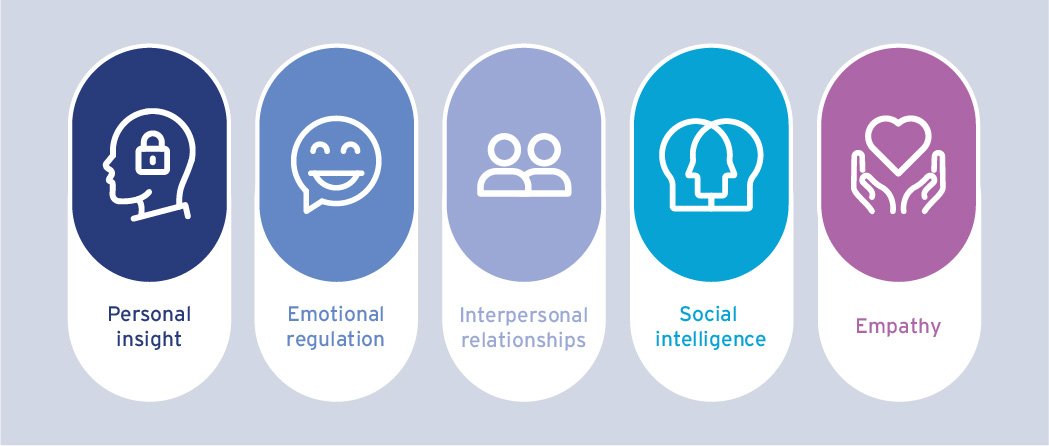Do you work with someone who can drive you a little crazy now and then? Then you’re in good company. In fact, 85% of us will experience some kind of conflict in the workplace at one time or another. Maybe it’s the manager who’s argumentative in meetings, the teammate who keeps starting and stopping projects you depend on, or the colleague who never shares their ideas. Whatever the case may be for you, chances are you’ve worked with them or someone like them before, and you understand how complex workplace life can be.
The thing is, as much as we’d like to choose our coworkers, we can’t. But we can choose how we respond to them. Emotional intelligence goes beyond just empathy. It’s a practical skill set that helps you spot challenging behaviors, respond thoughtfully, and become more aware of your own actions and motivations. That self-awareness empowers you make conscious choices instead of reacting purely on instinct. When used fully, EQ can turn potentially negative interactions into opportunities, making work relationships happier and much more productive.
Learn how to turn those frustrating behaviors in your coworkers into strengths that benefit everyone, including you.
Understanding what drives your coworkers
It’s helpful to remember that almost no one sets out to be “difficult” at work. Every workplace brings together people who think, communicate, and focus in very different ways, and adjusting to that mix takes patience and a bit of personal growth.
Most frustrating behaviors come from different priorities or experiences. The colleague who constantly interrupts might have grown up in a loud, busy household where speaking up was the only way to be heard. The teammate who doesn’t share their ideas might be busy carrying more on their plate than anyone realizes. Taking a moment to understand these motivations before reacting can make a huge difference in how you handle situations and the results you get.
By using EQ to understand common behaviors that are often misread, you can navigate difficult people and situations more effectively. Connecting with the people you work with is the best way to get the most out of your workplace, and your own growth.

Colleague type 1: Very direct or confrontational
We’ve all had that colleague who insists on “saying it like it is,” as if their opinion is the most important thing you’ll hear all day. This can often come in the form of blunt feedback, criticism without advice on how to improve, or speaking over you to air their own opinion. It can be hard to see how this behavior could be a strength and how you can draw something constructive out of it, but it can be done.
By using social regulation and recognition skills—essentially empathy and relationship management—which are part of the EQ toolkit, you can start to look past the delivery and focus on intent. What feels abrasive on the surface often masks a real knack for cutting through confusion and keeping things moving forward. People who communicate directly like this are often unafraid to make decisions and are able to take an idea and develop it quickly. Most of the time, this colleague simply wants to move things forward and get things done correctly.
While no one should ever have to tolerate aggression at work, learning to separate tone from intent can help you respond effectively. When you stay calm and focus on what they’re really trying to achieve, a blunt colleague’s directness can become an asset, by helping the team move faster and make clearer decisions by getting straight down to the core issues.
Colleague type 2: Struggles in loud or chaotic settings
Some people don’t thrive in noisy, chaotic environments. In open-plan offices, meetings, or large events, they may seem distracted or slow to respond. It’s easy to assume they’re not focused on their work, but often the opposite is true. They simply work best in calmer settings. When given quiet spaces and fewer interruptions, they can demonstrate incredible focus.
This is where your social awareness and self-management skills come in. They help you tune in to the emotional makeup of others and respond accordingly. By noticing how the environment affects your colleague’s behavior, and pausing before you make a snap judgement, you can make more accurate observations about what they actually need to do their best work.
From there, small adjustments can go a long way. Offering written updates, scheduling important conversations in quieter spaces, or giving them uninterrupted work time can reduce their stress and improve their performance. Supporting colleagues in this way benefits not only them but the whole team. After all, statistics show that happy employees are as much as 20% more productive at work than unhappy, stressed employees.
Colleague type 3: Not assertive with opinions
Not everyone is naturally vocal about their opinions. Some colleagues hold back, not because they lack ideas, but because speaking up doesn’t come easily. In the workplace there’s often a “they-who-speak-loudest-are-heard” dynamic, which can be difficult for everyone to adapt to. Quieter contributions often slip under the radar, and it can be exhausting to keep prompting someone to share their ideas. After all, you can’t be responsible for those who won’t help themselves, right?
The thing is, dismissing quieter voices is a mistake. Often, their ideas and expertise are just as valuable as those of more assertive colleagues, they just need a different environment to share them. Their silence isn’t a lack of effort. It’s simply a different way of engaging.
This is where your EQ skills come in. Self-awareness helps you notice your own bias before you write them off, and relationship management lets you create the kind of space where they feel safe to speak up, whether that’s inviting their input directly or showing genuine interest in their ideas.
When you affirm and build on their contributions, you give their voice weight and encourage them to keep sharing. That not only strengthens collaboration but also accesses additional experience and expertise that benefit the entire team, including you.

Start thriving alongside every type of coworker
At the end of the day, we can’t control who we work with, but we can control how we respond to them. In fact, 41% of workers report that conflict has actually helped them better understand their colleagues. What looks like confrontation, distraction, or silence can often be just a different communication style or coping mechanism. When you use emotional intelligence to really observe and understand the people around you, everyday frustrations turn into opportunities to collaborate.
The more you practice, the easier it gets to see the strengths behind the quirks and to draw the best out of every one of your colleagues no matter who they are. The goal is not to change anyone, but to understand their motivations and learn to meet them where they are, getting the most out of every situation. That is where your true power lies.
If you want to start levelling up your own emotional intelligence to get the best out of your colleagues and career then visit TerraYou and start your EQ journey.



